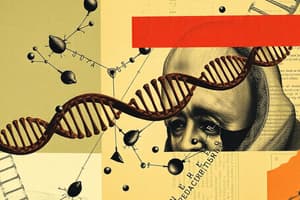Podcast
Questions and Answers
¿Cuál es el proceso en el que se duplica el ADN antes de la división celular?
¿Cuál es el proceso en el que se duplica el ADN antes de la división celular?
- Replicación de ADN (correct)
- Transcripción de ADN
- Transcripción inversa
- Reproducción de ARN
¿Qué proceso implica la creación de una copia de ARN a partir de una molécula de ADN en la célula?
¿Qué proceso implica la creación de una copia de ARN a partir de una molécula de ADN en la célula?
- Replicación de ARN
- Síntesis de Proteínas
- Translocación de ARN
- Transcripción de ADN (correct)
¿Cuál es el componente clave necesario para iniciar y regular la transcripción del ADN en la célula?
¿Cuál es el componente clave necesario para iniciar y regular la transcripción del ADN en la célula?
- Lípidos celulares
- Carbohidratos simples
- ARN ribosómico
- Factores de transcripción (correct)
¿Cuál es el proceso responsable de regular y controlar la expresión génica en un organismo?
¿Cuál es el proceso responsable de regular y controlar la expresión génica en un organismo?
¿Cuál es la función principal del código genético en relación con la síntesis proteica?
¿Cuál es la función principal del código genético en relación con la síntesis proteica?
Durante qué fase del ciclo celular se utiliza una hebra de ADN como plantilla para la transcripción, cuando la célula no está en división?
Durante qué fase del ciclo celular se utiliza una hebra de ADN como plantilla para la transcripción, cuando la célula no está en división?
¿Cuál de las siguientes afirmaciones sobre la transcripción es correcta?
¿Cuál de las siguientes afirmaciones sobre la transcripción es correcta?
¿Cuál es la función principal de los factores de transcripción?
¿Cuál es la función principal de los factores de transcripción?
En las células eucariotas, ¿cuál de los siguientes elementos NO está involucrado en la regulación de la expresión génica?
En las células eucariotas, ¿cuál de los siguientes elementos NO está involucrado en la regulación de la expresión génica?
¿Cuál de las siguientes afirmaciones sobre el código genético es FALSA?
¿Cuál de las siguientes afirmaciones sobre el código genético es FALSA?
¿Cuál de las siguientes afirmaciones sobre la replicación del ADN es VERDADERA?
¿Cuál de las siguientes afirmaciones sobre la replicación del ADN es VERDADERA?
¿Cuál de las siguientes afirmaciones sobre la regulación de la expresión génica en eucariotas es FALSA?
¿Cuál de las siguientes afirmaciones sobre la regulación de la expresión génica en eucariotas es FALSA?
Flashcards are hidden until you start studying
Study Notes
Molecular Biology and DNA Transcription
Molecular biology is the branch of science dealing with the study of the molecular basis of biological activity. One fundamental aspect of molecular biology is the process of DNA transcription, which is crucial for gene expression and, consequently, the functioning of an organism. DNA transcription involves the conversion of a segment of DNA into an RNA equivalent. This process is vital for several reasons, including the production of proteins, regulation of genetic material, and the maintenance of genetic stability. In this article, we will explore the various aspects of DNA transcription, including DNA replication, RNA synthesis, transcription factors, gene expression regulation, and the genetic code.
DNA Replication
Before discussing DNA transcription, let's consider DNA replication, another important process in molecular biology. DNA replication is the process by which DNA is duplicated prior to cell division. During replication, the double-stranded DNA molecule is separated into two separate strands, and each strand serves as a template for the synthesis of a new complementary strand. This results in the formation of two identical daughter DNA molecules. The separation of the two strands allows one of them to become a template for transcription during the interphase when the cell is not undergoing division.
RNA Synthesis
Once the cell enters the phase of DNA transcription, the DNA molecule is utilized to create an RNA copy. RNA polymerase, an enzyme responsible for the process, binds to the promoter region of the DNA template. After binding, the polymerase reads the DNA sequence and generates a corresponding RNA sequence. The RNA produced is generally a complementary copy of one of the DNA strands, except for the presence of uracil instead of thymine. Interestingly, the same strand that is used as a template for the transcription of one gene could be the non-template strand for other genes within the same region.
Transcription Factors
Transcription factors (TFs) are proteins that bind to specific DNA sequences, modifying the accessibility of the DNA template for transcription by RNA polymerase. These regulatory proteins either activate or inhibit the transcription process, allowing for precise control and coordination of gene expression in response to environmental cues or developmental signals. Transcription factors play a crucial role in the regulation of DNA transcription, as they can either promote or suppress the binding of RNA polymerase to the promoter region of target genes.
Gene Expression Regulation
Gene expression refers to the process by which genetic information encoded within DNA is used to produce proteins or functional RNA molecules. The regulation of gene expression involves various mechanisms that ensure specificity, efficiency, and accuracy in the production of cellular components. In eukaryotic cells, for example, the initiation stage of transcription involves the binding of RNA polymerase to a specialized sequence called a promoter. Eukaryotic promoters are more complex than their prokaryotic counterparts due to the presence of multiple classes of RNA polymerases (RNAP) and additional regulatory elements such as enhancer sequences. These elements allow for fine-tuning of transcription rates and location determination, ensuring proper gene expression.
Genetic Code
The genetic code is a set of rules that dictate how the nucleotide sequence in DNA is translated into amino acids during protein synthesis. This translation occurs via another essential molecular biology mechanism – transcription followed by translation. Once an RNA copy is generated from the DNA template through transcription, it serves as a blueprint for the construction of proteins. The transfer RNA (tRNA) molecules read this RNA sequence and bring together corresponding amino acids according to the genetic code, forming a polypeptide chain. This process ultimately leads to the formation of functional proteins, which carry out various tasks in the cell.
In conclusion, DNA transcription is a fundamental process in molecular biology that plays a critical role in gene expression and cellular function. Through the complex interplay of various elements such as RNA polymerase, transcription factors, promoters, enhancers, and genetic code, cells regulate their gene expression patterns to achieve specific biological outcomes. Understanding these mechanisms provides valuable insights into the intricacies of life at the molecular level and has significant implications for biotechnology and medicine.
Studying That Suits You
Use AI to generate personalized quizzes and flashcards to suit your learning preferences.




